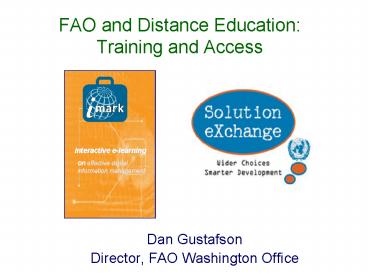FAO and Distance Education: Training and Access - PowerPoint PPT Presentation
1 / 32
Title:
FAO and Distance Education: Training and Access
Description:
Online Community - a 'virtual' community on the Internet for contributors and ... Connecting people with common interests in a more systematic fashion ... – PowerPoint PPT presentation
Number of Views:62
Avg rating:3.0/5.0
Title: FAO and Distance Education: Training and Access
1
FAO and Distance EducationTraining and Access
interactive e-learning
on effective digital information management
- Dan Gustafson
- Director, FAO Washington Office
2
- The Demand
- Requests from Member States for capacity
building - Advice
- Assistance and training
- Appropriate guidelines, methodologies and tools
- The Problem
- Inability to address demand with face-to-face
training - Insufficient human resources
- High cost
3
- But
- Knowledge needed to make an impact locally
resides all over, among practitioners - Access to this knowledge and experienceeven
within the same statecan be very difficult - How can this be done in an efficient and cost
effective manner beyond what is already
happening? - What is the role of FAO and the UN in this?
- India a particularly good example of the
challenge
4
- 1. Role of e-learning as training
- build awareness and understanding
- provide on-the-job training for technical staff
- make available tools, methodologies and
guidelines along with learning materials. - support face-to-face training and capacity
building activities
5
Distance Learning at FAO
Learning Resource Repositories FAO Capacity
Building Portal Education for Rural People
(FAOUNESCO) Rural Finance Learning Centre
(FAO-IFAD-WorldBank-GTZ) EASYPol - Policy
6
Distance Learning at FAO
Tutored Learning FODEPAL Agricultural
Policy (Latin America) The Right to Food
Integrated Food Security and Humanitarian Phase
Classification System
7
Distance Learning at FAO
Self-paced Learning Information Management
Resource Kit (IMARK) Rural Finance Learning
Centre EC-FAO Programme Food Security
Information for Action The Right to Adequate
Food Codex Alimentarius
8
Information Management Resource Kit
Initiated in 2001 as a partnership-based
e-learning Active collaboration with more than
30 international, regional and specialized
organizations.
interactive e-learning
on effective digital information management
9
- IMARK - Main Outputs
- Modules - a series of computer-based distance
learning curricula and resources for agricultural
information management. - Online Community - a "virtual" community on the
Internet for contributors and learners, allowing
them to exchange information, and to collaborate
with other professionals.
10
Modules Currently Available
- Management of Electronic Documents
- Digitization and Digital Libraries
- Investing in Information for Development
- Building Electronic Communities and Networks
- Networking for Development
11
- Collaborative Learning
- e-learning lessons are used as part of
synchronous courses delivered online - FAO has used Moodle (open source) and Blackboard
(commercial) learning management software to
deliver courses online - students work together in collaborative
workspaces and learn while doing - allows participants the opportunity to learn
together from geographically dispersed locations
12
2. E-learning as Access and Knowledge Exchange
and Management
- Recognition that access to what others know
within the country/state/province equally
critical - Connecting people with common interests in a more
systematic fashion - Creating communities of practices (CoPs) that
synthesize various development experiences - Impartial forumwith moderation and technical
backupto bring practitioners together to share
knowledge - Show how these experiences fit within global
archive -- benchmarks
13
Problems holding back knowledge and experience
sharing
- Experts mostly talk to each other in seminars and
workshops (and the best interact among
themselves) - Lack cross-disciplinary perspective approaches
- Significant gap between research priorities and
grass root problems - Knowledge of non-experts not heard or valued
14
http//www.solutionexchange-un.net.in
15
- A moderated mailgroup not an e-network exchange
alone. - Problems and challenges are put as QUERY in an
e-mail format - Members offer Advice, Experience, Contact or
Suggestions - A CONSOLIDATED RESPONSE prepared with SYNOPSIS of
original responses, ADDITIONAL RESOURCES and
LINKS - These are available on the website as Knowledge
Products - http//www.solutionexchange-un.net.in
- Along with e-discussion papers, e-consultations,
newsletters, action groups, annual meeting
16
(No Transcript)
17
How it works
1. Member sends the Community a query (day 1)
Help!
Help!
Help!
Help!
Help!
Help!
18
How it works
2. Community offers Member solutions (days 2-7)
Desk Research
19
How it works 3. Consolidated Reply is prepared,
sent archived (day 8)
Thank you!
To the Solutions Bank
20
- Sustainable improvements in food security- all
aspects of agriculture and issues from production
to marketing - Reduction in malnutrition and link between
nutrition and other programs (especially
agriculture) - Improved implementation of food security
programs, safety nets, food safety issues and
prevention of food borne diseases - From field level workers to researchers policy
makers --- anyone involved in food production,
nutrition, livelihood, access, food quality
safety, food processing, marketing
21
(No Transcript)
22
(No Transcript)
23
(No Transcript)
24
(No Transcript)
25
(No Transcript)
26
(No Transcript)
27
(No Transcript)
28
(No Transcript)
29
(No Transcript)
30
(No Transcript)
31
Outcomes in Food and Nutrition Security Community
- Excellent response 1800 members, 100 queries
and Consolidated Replies in three years - Particularly good for those who are not
nationally known - Matches the evolution of UNs role from Technical
Assistance to KM and solution exchange within
the country ( technical assistance) - Greater visibility and legitimacy to localized
experience - Impact on programs, both agriculture and nutrition
32
Challenges
- Deepening the reach of Solution Exchange
- Bringing in people/ orgn. who need knowledge
- Identifying where such knowledge rests
- Scaling up
- Overcoming barriers like literacy/ e-literacy
- Information in vernacular languages
- Access to power, telephony, internet
- Ensuring linkages with major Govt. programs































